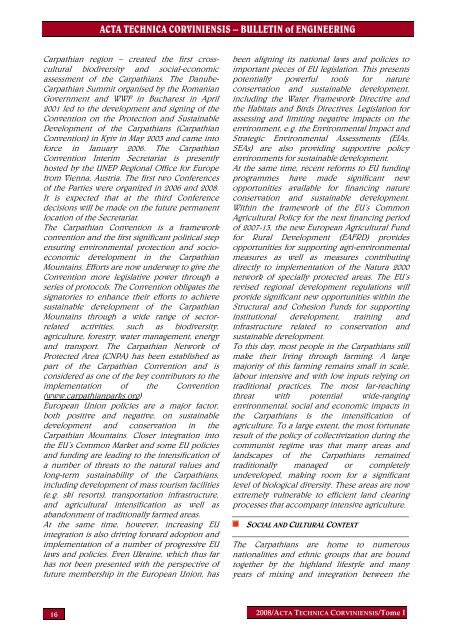Acta Technica Corviniensis
Acta Technica Corviniensis
Acta Technica Corviniensis
- No tags were found...
You also want an ePaper? Increase the reach of your titles
YUMPU automatically turns print PDFs into web optimized ePapers that Google loves.
ACTA TECHNICA CORVINIENSIS – BULLETIN of ENGINEERINGCarpathian region – created the first crossculturalbiodiversity and social-economicassessment of the Carpathians. The Danube-Carpathian Summit organised by the RomanianGovernment and WWF in Bucharest in April2001 led to the development and signing of theConvention on the Protection and SustainableDevelopment of the Carpathians (CarpathianConvention) in Kyiv in May 2003 and came intoforce in January 2006. The CarpathianConvention Interim Secretariat is presentlyhosted by the UNEP Regional Office for Europefrom Vienna, Austria. The first two Conferencesof the Parties were organized in 2006 and 2008.It is expected that at the third Conferencedecisions will be made on the future permanentlocation of the Secretariat.The Carpathian Convention is a frameworkconvention and the first significant political stepensuring environmental protection and socioeconomicdevelopment in the CarpathianMountains. Efforts are now underway to give theConvention more legislative power through aseries of protocols. The Convention obligates thesignatories to enhance their efforts to achievesustainable development of the CarpathianMountains through a wide range of sectorrelatedactivities, such as biodiversity,agriculture, forestry, water management, energyand transport. The Carpathian Network ofProtected Area (CNPA) has been established aspart of the Carpathian Convention and isconsidered as one of the key contributors to theimplementation of the Convention(www.carpathianparks.org)European Union policies are a major factor,both positive and negative, on sustainabledevelopment and conservation in theCarpathian Mountains. Closer integration intothe EU’s Common Market and some EU policiesand funding are leading to the intensification ofa number of threats to the natural values andlong-term sustainability of the Carpathians,including development of mass tourism facilities(e.g. ski resorts), transportation infrastructure,and agricultural intensification as well asabandonment of traditionally farmed areas.At the same time, however, increasing EUintegration is also driving forward adoption andimplementation of a number of progressive EUlaws and policies. Even Ukraine, which thus farhas not been presented with the perspective offuture membership in the European Union, hasbeen aligning its national laws and policies toimportant pieces of EU legislation. This presentspotentially powerful tools for natureconservation and sustainable development,including the Water Framework Directive andthe Habitats and Birds Directives. Legislation forassessing and limiting negative impacts on theenvironment, e.g. the Environmental Impact andStrategic Environmental Assessments (EIAs,SEAs) are also providing supportive policyenvironments for sustainable development.At the same time, recent reforms to EU fundingprogrammes have made significant newopportunities available for financing natureconservation and sustainable development.Within the framework of the EU’s CommonAgricultural Policy for the next financing periodof 2007-13, the new European Agricultural Fundfor Rural Development (EAFRD) providesopportunities for supporting agri-environmentalmeasures as well as measures contributingdirectly to implementation of the Natura 2000network of specially protected areas. The EU’srevised regional development regulations willprovide significant new opportunities within theStructural and Cohesion Funds for supportinginstitutional development, training andinfrastructure related to conservation andsustainable development.To this day, most people in the Carpathians stillmake their living through farming. A largemajority of this farming remains small in scale,labour intensive and with low inputs relying ontraditional practices. The most far-reachingthreat with potential wide-rangingenvironmental, social and economic impacts inthe Carpathians is the intensification ofagriculture. To a large extent, the most fortunateresult of the policy of collectivization during thecommunist regime was that many areas andlandscapes of the Carpathians remainedtraditionally managed or completelyundeveloped, making room for a significantlevel of biological diversity. These areas are nowextremely vulnerable to efficient land clearingprocesses that accompany intensive agriculture.SOCIAL AND CULTURAL CONTEXTThe Carpathians are home to numerousnationalities and ethnic groups that are boundtogether by the highland lifestyle and manyyears of mixing and integration between the162008/ACTA TECHNICA CORVINIENSIS/Tome I
















